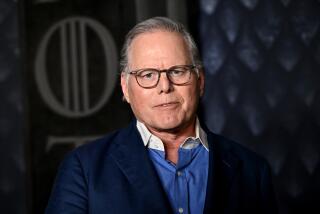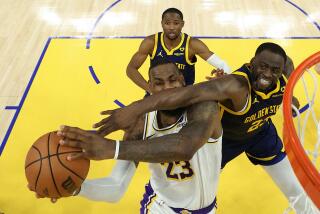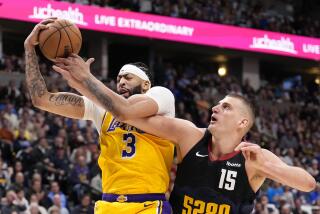The $40-Million Quest(ion)
- Share via
“The Real Adventures of Jonny Quest” has all the earmarks of an ambitious feature film project: Two years of marketing fanfare, what some characterize as serious budget overruns, a promotional push valued at more than $40 million, and a thick skein of tie-ins with fast-food, cereal, snack and toy makers aimed at piquing the curiosities of kids throughout the world.
But Jonny and his sidekicks, Bandit and Hadji--well-remembered by middle-age boomers who watched the 1960s adventure cartoon--are not movie stars yet. They first are returning to the small screen, having debuted on three cable networks owned by Turner Broadcasting System Inc. this week as part of the Atlanta-based company’s effort to reinvigorate properties idling in its library.
The remake of the classic “Jonny Quest” TV series not only boasts one of the most elaborate and expensive marketing campaigns in cable history, but may be the most ambitious project undertaken by Hanna-Barbera Cartoons Inc. since it was purchased in 1991 by Turner.
It could well be the last blast from Turner before it is reconstituted in a merger with Time Warner Inc. later this year. Hollywood sources have speculated that Hanna-Barbera will lose its independence and be absorbed by Warner Bros.’ animation group.
Some analysts believe Hanna-Barbera, viewed as mostly an in-house supplier to Turner’s Cartoon Network, hasn’t done enough with its legacy as the creator of “The Flintstones,” “The Jetsons” and “Jonny Quest.”
Turner has pulled out all the stops to make this library classic a hit. And its campaign demonstrates anew how today’s entertainment conglomerates can pool the powers of their various divisions to promote a common cause, in this case breaking conventional formulas that restrict the marketing of TV shows, particularly on cable.
“This is as big a push for one television show as I’ve ever seen,” said Michael Schau, executive editor of the Entertainment Marketing Letter, a newsletter based in New York. “NBC will spend a lot for a fall season and maybe on a miniseries, but this is more in line with a feature film release, and could be the start of marketing wars in television that have made theatricals so expensive.”
NBC says it backs new prime-time series with promotions valued at between $700,000 and $1.2 million; it showered its highly rated “Gulliver’s Travels” extravaganza in February with roughly $12 million worth of promotions.
Children’s shows typically attract legions of marketing partners once they become hits because of the value of toys, lunch boxes and videos featuring characters loved by kids. Disney in particular has massed elaborate campaigns around the launch of its children’s TV series: It has pulled together a promotional package worth an estimated $150 million for the syndicated two-hour segment known as “The Disney Afternoon” that includes the new “The Mighty Ducks,” which will also debut next week on ABC’s Saturday morning lineup.
But ratings on cable generally are too tiny to draw initial promotional firepower to single programs, making the Quest launch a curiosity. Whereas most children’s television shows lack extensive promotional tie-ins at their launch, Turner lined up about 30 partners with cereal box offers, toys, T-shirts and the like even before the first episode aired Monday.
Lewis Galub Toys shipped its first action figures to major retailers such as Wal-Mart and Toys R Us three weeks ago and is already renewing orders because of brisk demand.
“We have not even advertised that this product is out there,” said Richard Nile of Galub. “It could very well be collectors, who are usually well aware of licensing and when a product is scheduled to launch. Collector groups are large--Star Trek has 200,000 to 300,000.”
Hanna-Barbera picked Jonny Quest from its library of 3,000 animated half-hour shows not only to tap into the current success of adventure cartoons, such as Fox’s “X-Men,” but because of the cult following of Quest among baby boomers and adult-animation groupies, who are known in the industry as “Skippies.”
“Jonny Quest got more attention from fans than any other library character than the Flintstones,” said Fred Seibert, president of Hanna-Barbera, which has sought to relaunch one property from its library a year. Quest is the second try, with “The Flintstones” movie a few years back its first. “The Jetsons” could show up in prime time in 1998, after a movie debut.
Turner’s own internal push was also a big factor in drawing early promotional support to Quest. The show is airing in prime time on Turner’s fledgling Cartoon Network, and also earlier in the day and on Saturdays on two other networks in the family, TNT and TBS. Together, the three networks will run episodes of the show 21 times a week--helping to offset cable’s limited reach and low ratings.
“For partners to be interested, they want an event, and you can’t get that with a 2 [ratings] share,” Seibert said. “But four exhibitions a day might have a similar impact to a broadcast outlet. There is no other family of cable networks able to give multiple openings in this way.”
Because Turner controls both the product and the distribution, it could also guarantee partners that Quest would have a chance to build an audience, rather than be yanked because of low ratings. “We have a two-season commitment from the networks,” said Pam Kaufman, vice president of promotion for Turner Home Entertainment, noting that most shows get 13-week commitments.
The licensing partnerships and commitment on Turner networks also comforted foreign buyers. Although most television shows are sold overseas once they are proven successes at home, Quest is airing this fall in 40 countries.
The series is expected to give the Cartoon Network, which is one of the fastest-growing channels, a needed anchor series. Seibert said it will take 60 days to get solid readings on the Quest ratings and that he is waiting until school starts for the buzz on the show to circulate. But on the strength of a marketing push that has included air time on the Turner networks and licensed products, he said the show is already scoring ratings double the network average and 18% above those for the preceding show.
Still, the project ran into production snafus that threatened to wreak havoc with the broadcast deadline. Roughly 18 months into the production cycle, Hanna-Barbera dismissed the original creative team and, according to some sources, was running 30% over budget because of false starts and ambitious and innovative animation plans. In the end, Seibert said, the studio spent on the high end of the typical costs for animated TV episodes, which can run from $250,000 to $500,000. Although two separate teams produced the 52 episodes and several cast members were let go halfway through, Seibert said the viewers won’t be able to tell.
But as one animation expert said: “They sold the show to licensees and the public as a revolutionary animation project. I don’t know if it lives up to that, but in the end, kids will decide.”
More to Read
The biggest entertainment stories
Get our big stories about Hollywood, film, television, music, arts, culture and more right in your inbox as soon as they publish.
You may occasionally receive promotional content from the Los Angeles Times.










